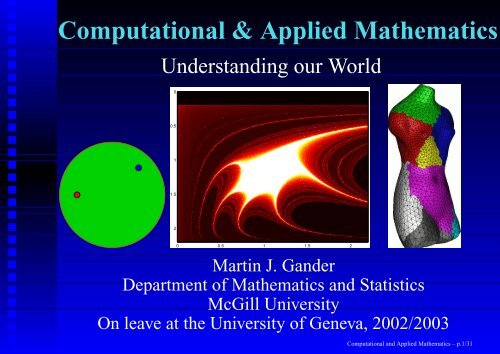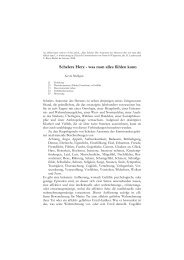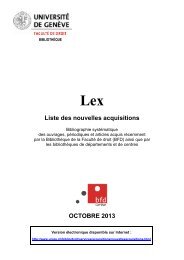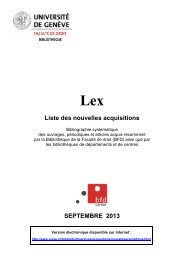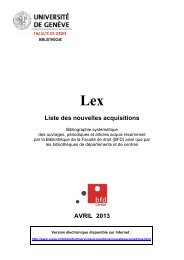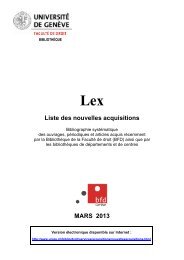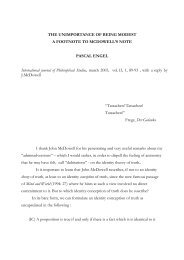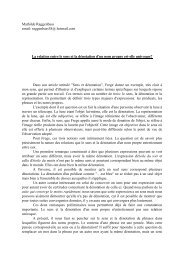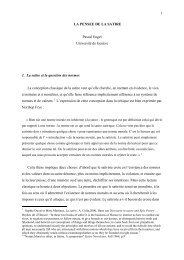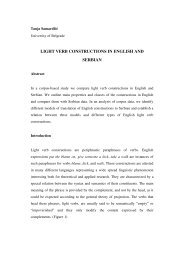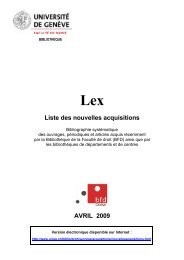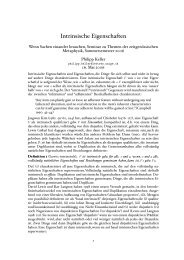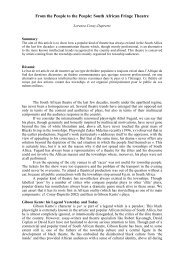Computational & Applied Mathematics
Computational & Applied Mathematics
Computational & Applied Mathematics
Create successful ePaper yourself
Turn your PDF publications into a flip-book with our unique Google optimized e-Paper software.
<strong>Computational</strong> & <strong>Applied</strong> <strong>Mathematics</strong><br />
Understanding our World<br />
0<br />
0.5<br />
1<br />
1.5<br />
2<br />
0 0.5 1 1.5 2<br />
Martin J. Gander<br />
Department of <strong>Mathematics</strong> and Statistics<br />
McGill University<br />
On leave at the University of Geneva, 2002/2003<br />
<strong>Computational</strong> and <strong>Applied</strong> <strong>Mathematics</strong> – p.1/31
Optimal Intercept Time<br />
y<br />
x0<br />
Suspect Vessel: speed v<br />
Police Boat: speed u<br />
y0<br />
What direction does the police boat have to choose<br />
to approach the suspect vessel up to a distance R as<br />
quickly as possible ?<br />
x<br />
<strong>Computational</strong> and <strong>Applied</strong> <strong>Mathematics</strong> – p.2/31
Geometric Solution<br />
y<br />
x0<br />
y0<br />
Imagine the police boat going into all directions at the<br />
same time =⇒ y 2 0 + (vt − x0) 2 = (ut + R) 2 .<br />
In “Note on the Optimal Intercept Time of Vessels to a Nonzero Range”<br />
G, SIAM Review Vol. 40, No. 3, 1998.<br />
R<br />
x<br />
<strong>Computational</strong> and <strong>Applied</strong> <strong>Mathematics</strong> – p.3/31
The Donut Problem<br />
Top View<br />
Side View<br />
What is the maximum number of pieces one can get<br />
from a donut when cutting it with three planar cuts ?<br />
Starting with an apple, how many pieces can we get ?<br />
<strong>Computational</strong> and <strong>Applied</strong> <strong>Mathematics</strong> – p.4/31
First Cut<br />
Top view First cut<br />
The most we can get with a single planar cut is two<br />
pieces.<br />
<strong>Computational</strong> and <strong>Applied</strong> <strong>Mathematics</strong> – p.5/31
Second Cut<br />
Top view<br />
First and second cut<br />
We get six pieces in total, each of the first two is cut<br />
twice.<br />
<strong>Computational</strong> and <strong>Applied</strong> <strong>Mathematics</strong> – p.6/31
Third Cut<br />
How many pieces do we have now ?<br />
<strong>Computational</strong> and <strong>Applied</strong> <strong>Mathematics</strong> – p.7/31
The Total Number of Pieces is<br />
4<br />
Upper top octant:<br />
5<br />
3 pieces<br />
1<br />
2<br />
3<br />
Lower top octant:<br />
2 pieces<br />
Upper left octant:<br />
8<br />
6<br />
7<br />
Lower left octant:<br />
1 piece<br />
15 Pieces with 3 planar cuts.<br />
2 pieces 1 piece<br />
Upper right octant:<br />
10<br />
9<br />
14<br />
Lower right octant:<br />
1 piece<br />
Upper bottom octant:<br />
15<br />
11<br />
3 pieces<br />
12<br />
13<br />
Lower bottom octant:<br />
2 pieces<br />
<strong>Computational</strong> and <strong>Applied</strong> <strong>Mathematics</strong> – p.8/31
Is this Solution Really Correct ?<br />
The answer is NO, the maximum number of pieces<br />
one can get is 13 ! How ?<br />
An article by Martin Gardner in the “Scientific<br />
American” contains the general result for a torus in n<br />
dimensions and m cuts along hyperplanes.<br />
Suppose you are allowed to move the pieces between<br />
the cuts, what is now the maximum number of pieces<br />
you can get ?<br />
<strong>Computational</strong> and <strong>Applied</strong> <strong>Mathematics</strong> – p.9/31
Circular Billiard<br />
In which direction do you have to push the red ball so<br />
that it bounces of the rim exactly once and then hits<br />
the blue ball ?<br />
Is there more than one solution ? <strong>Computational</strong> and <strong>Applied</strong> <strong>Mathematics</strong> – p.10/31
Circular Billiard: Algebraic Solution<br />
PSfrag replacements<br />
b<br />
y<br />
θ<br />
−c a<br />
f(θ) = (1 + c cos θ) (a − cos θ) 2 + (b − sin θ) 2<br />
− (1 − a cos θ − b sin θ) (c + cos θ) 2 + (sin θ) 2<br />
γ<br />
1<br />
x<br />
<strong>Computational</strong> and <strong>Applied</strong> <strong>Mathematics</strong> – p.11/31
cements<br />
f(θ)<br />
Solution for the Given Example<br />
0.4<br />
0.3<br />
0.2<br />
0.1<br />
0<br />
−0.1<br />
−0.2<br />
PSfrag replacements<br />
θ<br />
−0.3<br />
0 1 2 3 4 5 6 7<br />
θ<br />
f(θ)<br />
Are there always four solutions ?<br />
150<br />
210<br />
120<br />
240<br />
90<br />
180 0<br />
270<br />
0.4<br />
0.2<br />
1<br />
0.8<br />
0.6<br />
60<br />
300<br />
<strong>Computational</strong> and <strong>Applied</strong> <strong>Mathematics</strong> – p.12/31<br />
30<br />
330
The Geometric Point of View<br />
PSfrag replacements<br />
m2<br />
y<br />
−e m1<br />
θ<br />
α<br />
We need to find an ellipse which touches the circle tan-<br />
gentially.<br />
e<br />
1<br />
x<br />
<strong>Computational</strong> and <strong>Applied</strong> <strong>Mathematics</strong> – p.13/31
Number of Solutions<br />
An example with 4 solutions and one with 2 only.<br />
Q(u) = (m2−m2m1)u 4 +(2m1−2m 2 1 +2e2 +2m 2 2 )u3 +6u 2 m2m1<br />
+ (−2m 2 2 + 2m 2 1 + 2m1 − 2e 2 )u − m2m1 − m2 = 0<br />
where θ = 2 arctan(u). Q(u) is a 4th degree<br />
polynomial, there can not be more than four solutions.<br />
<strong>Computational</strong> and <strong>Applied</strong> <strong>Mathematics</strong> – p.14/31
Dependence on the Ball Position<br />
A numerical experiment: fixing the position of one<br />
ball and varying the position of the second ball.<br />
Counting the number of solutions gives the gray<br />
shade:<br />
<strong>Computational</strong> and <strong>Applied</strong> <strong>Mathematics</strong> – p.15/31
Dependence on the Ball Position<br />
The separatrix (x,y) can be computed analytically (t parameter):<br />
x(t) = − c<br />
h<br />
(1 + c)t 6 + 3(1 + 3c)t 4 + 3(1 − 3c)t 2 + (1 − c) ,<br />
y(t) = 16<br />
h c2 t 3 , h = (1 + 3c + 2c 2 )t 6 + 3(1 + c + 2c 2 )t 4 +<br />
+3(1 − c + 2c 2 )t 2 + (1 − 3c + 2c 2 )<br />
where c is the position of the fixed ball on the x axis.<br />
<strong>Computational</strong> and <strong>Applied</strong> <strong>Mathematics</strong> – p.16/31
Dependence on the Ball Position<br />
Top view of a coffee mug with a point source of light<br />
emulating the circular billiard game<br />
(Drexler and G, SIAM review Vol. 40, No. 2, 1998)<br />
<strong>Computational</strong> and <strong>Applied</strong> <strong>Mathematics</strong> – p.17/31
Digital Signal Processing<br />
A periodic signal f(t) can be decomposed into its<br />
Fourier components:<br />
f(t) =<br />
∞<br />
k=−∞<br />
ˆfke ikt .<br />
Discrete version: for the vector f of length n, where<br />
fj := f(tj), tj = j∆t, ∆t = 2π/n, we have<br />
fj =<br />
n−1<br />
k=0<br />
ˆfke iktj .<br />
What if the signal is an image, or a piece of music?<br />
<strong>Computational</strong> and <strong>Applied</strong> <strong>Mathematics</strong> – p.18/31
Population Dynamics<br />
Joint work with Antonio Steiner, Il Volterriano<br />
1997-2003<br />
<strong>Computational</strong> and <strong>Applied</strong> <strong>Mathematics</strong> – p.19/31
The Lotka Volterra System<br />
We consider rabbits and foxes living in a common<br />
habitat. If x denotes the rabbit population and y the<br />
fox population, the Lotka Volterra model states<br />
˙x = x − xy<br />
˙y = −y + xy<br />
Approximating the derivative using its definition:<br />
x(tn+1) − x(tn)<br />
∆t<br />
y(tn+1) − y(tn)<br />
∆t<br />
= x(tn) − x(tn)y(tn)<br />
= −y(tn) + x(tn)y(tn)<br />
We get a discrete dynamical system. <strong>Computational</strong> and <strong>Applied</strong> <strong>Mathematics</strong> – p.20/31
Solutions<br />
The exact solutions are cycles, but in general exact<br />
solutions can not be found. Numerical solutions<br />
spiral:<br />
y<br />
2.5<br />
2<br />
1.5<br />
1<br />
0.5<br />
0<br />
0 0.5 1 1.5 2 2.5<br />
x<br />
y<br />
3<br />
2.5<br />
2<br />
1.5<br />
1<br />
0.5<br />
0<br />
0 0.5 1 1.5<br />
x<br />
2 2.5 3<br />
<strong>Computational</strong> and <strong>Applied</strong> <strong>Mathematics</strong> – p.21/31
A Symplectic Method<br />
A very small change in the original method, instead of<br />
x(tn+1) − x(tn)<br />
∆t<br />
y(tn+1) − y(tn)<br />
∆t<br />
= x(tn) − x(tn)y(tn)<br />
= −y(tn) + x(tn)y(tn)<br />
changing in the second line tn to tn+1,<br />
x(tn+1) − x(tn)<br />
∆t<br />
y(tn+1) − y(tn)<br />
∆t<br />
= x(tn) − x(tn)y(tn)<br />
= −y(tn) + x(tn+1)y(tn)<br />
leads to a method for which one can prove that the<br />
approximate solution is cyclic like the exact solution.<br />
<strong>Computational</strong> and <strong>Applied</strong> <strong>Mathematics</strong> – p.22/31
Success...<br />
4<br />
3.5<br />
3<br />
2.5<br />
2<br />
1.5<br />
1<br />
0.5<br />
0<br />
−1 0 1 2 3 4 5 6<br />
The approximate solutions are also cycles, like the<br />
mathematically exact or “biological” ones.<br />
<strong>Computational</strong> and <strong>Applied</strong> <strong>Mathematics</strong> – p.23/31
and Failure of the new method<br />
4<br />
3<br />
2<br />
1<br />
0<br />
−1<br />
−2<br />
−25 −20 −15 −10 −5 0 5 10<br />
4<br />
3.5<br />
3<br />
2.5<br />
2<br />
1.5<br />
1<br />
0.5<br />
0<br />
−1 0 1 2 3 4 5 6<br />
But here, in spite of the proof of cyclic behavior, the<br />
method failed. On the right one can see why with the<br />
zoom!<br />
<strong>Computational</strong> and <strong>Applied</strong> <strong>Mathematics</strong> – p.24/31
So When does the Method Work?<br />
0<br />
0.5<br />
1<br />
1.5<br />
2<br />
0 0.5 1 1.5 2<br />
The boundary beteween where the method works and<br />
where it does not is very complicated: it is a fractal.<br />
<strong>Computational</strong> and <strong>Applied</strong> <strong>Mathematics</strong> – p.25/31
Room Temperature in Montreal<br />
∂u<br />
∂t (x, t) = ∂2u ∂x2 (x, t)+ ∂2u ∂y2 (x, t)+ ∂2u ∂z<br />
2 (x, t)+f(x, t)<br />
Room temperature<br />
in our living room<br />
in Montreal (outside<br />
temperature up to -47<br />
degrees): the heat equation.<br />
Insulated walls, not<br />
well insulated windows<br />
and doors.<br />
<strong>Computational</strong> and <strong>Applied</strong> <strong>Mathematics</strong> – p.26/31
Why a Turntable in the Microwave ?<br />
0.3<br />
0.25<br />
0.2<br />
0.15<br />
0.1<br />
0.05<br />
0<br />
The physical model is Maxwell’s equation<br />
∇ × E = −µHt,<br />
∇ × H = εEt + σE<br />
0.05 0.1 0.15 0.2 0.25 0.3 0.35 0.4 0.45 0.5<br />
<strong>Computational</strong> and <strong>Applied</strong> <strong>Mathematics</strong> – p.27/31
Why a Turntable in the Microwave ?<br />
0.3<br />
0.25<br />
0.2<br />
0.15<br />
0.1<br />
0.05<br />
0<br />
The physical model is Maxwell’s equation<br />
∇ × E = −µHt,<br />
∇ × H = εEt + σE<br />
0.05 0.1 0.15 0.2 0.25 0.3 0.35 0.4 0.45 0.5<br />
0.3<br />
0.25<br />
0.2<br />
0.15<br />
0.1<br />
0.05<br />
0<br />
0.05 0.1 0.15 0.2 0.25 0.3 0.35 0.4 0.45 0.5<br />
<strong>Computational</strong> and <strong>Applied</strong> <strong>Mathematics</strong> – p.27/31
Noise Levels in a VOLVO S90<br />
Noise simulation on a parallel<br />
computer to improve<br />
passenger comfort<br />
14<br />
2<br />
6<br />
12<br />
10<br />
4 3 5<br />
8<br />
16<br />
7<br />
11<br />
15<br />
<strong>Computational</strong> and <strong>Applied</strong> <strong>Mathematics</strong> – p.28/31<br />
9<br />
13<br />
1
Radiation Therapy for Cancer<br />
For cancer treatment it is important to have a very pre-<br />
cise model of the body part that will be exposed to ra-<br />
diation.<br />
<strong>Computational</strong> and <strong>Applied</strong> <strong>Mathematics</strong> – p.29/31
Aircraft Industry: B-747 in Flight<br />
Simulation of a B-<br />
747 flying through a<br />
thunderstorm, computation<br />
of the ice<br />
accumulation on the<br />
wings and around<br />
the engine intake.<br />
<strong>Computational</strong> and <strong>Applied</strong> <strong>Mathematics</strong> – p.30/31
The Fundamental Role of CAM<br />
Physics:<br />
− Fluid Dynamics<br />
− Aero Dynamics<br />
− Radiation<br />
− Particle Physics<br />
Engineering:<br />
− Circuits Simulation<br />
− Active Noise Cancellation<br />
− Cellular Phone Systems<br />
0.4<br />
0.3<br />
0.2<br />
0.1<br />
0<br />
0 0.2 0.4 0.6 0.8 1<br />
<strong>Computational</strong><br />
AND<br />
<strong>Applied</strong> <strong>Mathematics</strong><br />
0.9<br />
0.8<br />
0.7<br />
0.6<br />
0.5<br />
0.4<br />
0.3<br />
0.2<br />
0.1<br />
Biology:<br />
− Population Dynamics<br />
− Antibiotics<br />
− Micromachines<br />
0<br />
0.5<br />
1<br />
1.5<br />
2<br />
0 0.5 1 1.5 2<br />
Pure <strong>Mathematics</strong>:<br />
− Geometry<br />
− Asymptotics<br />
− Existence<br />
See also: www.math.mcgill.ca/mgander<br />
<strong>Computational</strong> and <strong>Applied</strong> <strong>Mathematics</strong> – p.31/31


